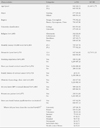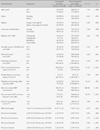Abstract
Purpose
The purpose of this study was to identify predictors of HPV (Human papillomavirus) vaccination among female university students.
Methods
The participants in this study were 1,486 female university students. Data were collected using self-administered questionnaire from september 1, 2010 to June 30, 2011. Data were analysed using descriptive statistics, t-test, χ2-test and logistic regression.
Results
The rate of HPV vaccination was 7.2%. Factors that influence HPV vaccination included residential region, smoking experience, family history of cervical cancer, experience having heard about the HPV vaccination, awareness that HPV is a sexual disease, HPV knowledge, perceived seriousness, perceived benefit and perceived barrier in health beliefs.
Conclusion
The results suggest a need to increase HPV vaccination campaigns to increase awareness of HPV vaccination. University and health care facilities should provide health education emphasizing perceived seriousness and perceived benefits. Also, the national health insurance corporation should consider addressing cost issues as a barrier to HPV vaccination.
Figures and Tables
References
1. Baseman J.G., Koutsky L.A. The epidemiology of human papillomavirus infections. Journal of Clinical Virology: the Official Publication of the Pan American Society for Clinical Virology. 2005. 32:Suppl 1. S16–S24.
2. Bednarczyk R.A., Birkhead G.S., Morse D.L., Doleyres H., McNutt L.A. Human papillomavirus vaccine uptake and barriers: association with perceived risk, actual risk and race/ethnicity among female students at a New York State university. Vaccine. 2011. 29(17):3138–3143.
3. Bendik M.K., Mayo R.M., Parker V.G. Knowledge, perceptions, and motivations related to HPV vaccination among college women. Journal of Cancer Education. 2011. Retrieved July 21, 2011. from http://www.springerlink.com/content.html.
4. Genital HPV infection. Centers for Disease Control and Prevention. 2008. Retrieved August 7, 2011. from http://www.cdc.gov.
5. Choi K.A., Kim J.H., Lee K.S., Oh J.K., Liu S.N., Shin H.R. Knowledge of human papillomavirus infection and acceptability of vaccination among adult women in Korea. Korean Journal of Obstetrics and Gynecology. 2008. 51(6):617–623.
6. Daley E.M., Vamos C.A., Buhi E.R., Kolar S.K., McDermott R.J., Hernandez N., et al. Influences on human papillomavirus vaccination status among female college students. Journal of Women's Health. 2010. 19(10):1885–1891.
7. Annual HPV vaccine coverage in England in 2009/2010. Department of Health. 2011. Retrieved August 1, 2011. from http://www.dh.gov.uk/en.
8. Dunne E.F., Unger E.R., Sternberg M., McQuillan G., Swan D.C., Patel S.S., et al. Prevalence of HPV infection among females in the United States. Journal of the American Medical Association. 2007. 297(8):813–819.
9. Parkin D.M, Bray P., Ferlay J., Pizani P.. Global cancer statistics, 2002. CA: A Cancer Journal for Clinicians. 2005. 55(2):74–108.
10. Gerend M.A., Magloire Z.F. Awareness, knowledge, and beliefs about human papillomavirus in a racially diverse sample of young adults. Journal of Adolescent Health. 2008. 42:237–242.
11. Han Y.J., Lee S.R., Kang E.J., Kim M.K., Kim N.H., Kim H.J., et al. Knowledge regarding cervical cancer, human papillomavirus and future acceptance of vaccination among girls in their Late teens in Korea. Korean Journal of Obstetrics and Gynecology. 2007. 50(8):1090–1099.
12. All about HPV vaccine. Healthchosun. 2011. Retrieved August 2, 2011. from http://health.chosun.com.
13. Hsu Y.Y., Fetzer S.J., Hsu K.F., Chang Y.Y., Huang C.P., Chou C.Y. Intention to obtain human papillomavirus vaccination among taiwanese undergraduate women. Sexually Transmitted Diseases. 2009. 36(11):686–692.
14. Jones M., Cook R. Intent to receive an HPV vaccine among university men and women and implications for vaccine administration. Journal of American College Health: J of ACH. 2008. 57(1):23–32.
15. Kahn J.A., Rosenthal S.L., Hamann T., Bernstein D.I. Attitudes about human papillomavirus vaccine in young women. International Journal of STD & AIDS. 2003. 14(5):300–306.
16. Kang H.Y., Kim J.S. Knowledge, attitudes of human papillomavirus (HPV) Vaccine, and intention to obtain HPV vaccine among Korean female undergraduate students. 2011. Manuscript submitted for publication.
17. Kim H.W., Ahn H.Y. Study on the knowledge of human papilloma virus in female university students. Korean Journal of Women Health Nursing. 2007. 13(1):13–20.
18. Kim Y.T. Prophylactic vaccine for cervical carcinoma. Journal of the Korean Medical Association. 2007. 50(2):151–158.
19. Kovacic M.B., Castle P.E., Herrero R., Schiffman M., Sherman M.E., Wacholder S., et al. Relationships of human papillomavirus type, qualitative viral load, and age with cytologic abnormality. Cancer Research. 2006. 66(20):10112–10119.
20. Lee E.J., Park J.S. Knowledge about cervical cancer, health beliefs and human papillomavirus vaccination rate in female university students. Journal of Korean Oncology Nursing. 2011. 11(1):65–73.
21. Lenselink C.H., Schmeink C.E., Melchers W.J., Massuger L.F., Hendriks J.C., Hamont D., et al. Young adults and acceptance of the human papillomavirus vaccine. Public Health. 2008. 122(12):1295–1301.
22. Marlow L.A., Waller J., Evans R.E., Wardle J. Predictors of interest in HPV vaccination: A study of British adolescents. Vaccine. 2009. 27(18):2483–2488.
23. Moscicki A.B., Shiboski S., Broering J., Powell K., Clayton L., Jay N., et al. The natural history of human papillomavirus infection as measured by repeated DNA testing in adolescent and young women. Journal of Pediatrics. 1998. 132(2):277–284.
24. Cancer statistics. National Cancer Information Center. 2009. Retrieved August 11, 2011. from http://www.cancer.go.kr/cms/stastics/incidence/index.html.
25. Rondy M., van Lier A., van de Kassteele J., Rust L., de Melker H. Determinants for HPV vaccine uptake in the Netherlands: A multilevel study. Vaccine. 2010. 28(9):2070–2075.
26. Schiffman M., Kjaer S.K. Natural history of anogenital human papillomavirus infection and neoplasia. Journal of the National Cancer Institute. 2003. 31:14–19.
27. Taylor L.D., Hariri S., Sternberg M., Dunne E.F., Markowitz L.E. Human papillomavirus vaccine coverage in the united states, national health and nutrition examination survey, 2007-2008. Preventive Medicine. 2011. 52(5):398–400.
28. Kumar V.M., Whynes D.K. Explaining variation in the uptake of HPV vaccination in England. BMC Public Health. 2011. 11:172.
29. Walboomers J.M., Jacobs M.V., Manos M.M., Bosch F.X., Kummer J.A., Shah K.V., et al. Human papillomavirus is a necessary cause of invasive cervical cancer worldwide. Journal of Pathology. 1999. 189:12–19.
30. Within 10 years, increased 64% GRDP in BUSAN. Yonhapnews. 2011. Retrieved July 22, 2011. from http://www.yonhapnews.co.kr.




 PDF
PDF ePub
ePub Citation
Citation Print
Print






 XML Download
XML Download